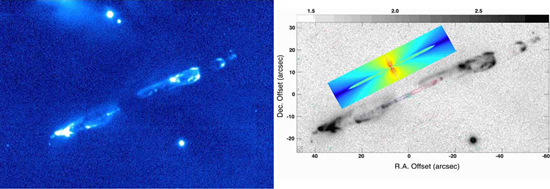Research Gallery > Star Formation Studies
Research Gallery
Star Formation Studies
| The HH211 outflow |
|
Image Credit: Hirano et al.

The HH211 outflow. Left: The H2 emission observed with the Very Large Telescope. Right: The approaching and receding SiO emission (blue and red contours, respectively) observed with the SMA superposed on the H2 image (Hirano et al. 2006, ApJ, 636, L141).
|
| Located at about 315 pc (1,000 light years) away in the constellation Perseus, HH211 is the youngest system that ever offers a close look at the regions inside of the molecular outflow. The H2 image, which is an excellent tracer of shocked molecular gas, reveals a well collimated jet emanating from a very young low-mass protostar embedded in the central obscured region. The SiO(5-4) image observed with the SMA, traces warm and very dense gas. It is evident that the SiO(5-4) emission, moving at a high velocity, comes from the narrow jet-like region with its approaching part in the east and receding part in the west of the obscured young star located at the peak of the green contours. The overall morphology of HH211 also suggests that the jet is driving the larger outflow traced in CO. The kinematics of the SiO(5-4) detected by the SMA, on the other hand, implies that the warm and high density gas originates and is expanding from an inner region that is beyond the resolution of the SMA, a phenomenon often seen in optical jets of the much more evolved and revealed T-Tauri stars. |
 asiaa.sinica.edu.tw Media Request: epo
asiaa.sinica.edu.tw Media Request: epo asiaa.sinica.edu.tw
asiaa.sinica.edu.tw 